 A south Jersey nursery/greenhouse operation has a probable infestation of European pepper moth, Duponchelia fovealis, family Crambidae. This group of moths includes European corn borer and garden webworms. Both adults and larvae have been found. [Read more…]
A south Jersey nursery/greenhouse operation has a probable infestation of European pepper moth, Duponchelia fovealis, family Crambidae. This group of moths includes European corn borer and garden webworms. Both adults and larvae have been found. [Read more…]
Vegetable Crops Edition
Seasonal updates and alerts on insects, diseases, and weeds impacting vegetable crops. New Jersey Commercial Vegetable Production Recommendations updates between annual publication issues are included.
Subscriptions are available via EMAIL and RSS.
Quick Links:
 NJ Commercial Vegetable Production Recommendations
NJ Commercial Vegetable Production Recommendations
 Rutgers Weather Forecasting - Meteorological Information important to commercial agriculture.
Rutgers Weather Forecasting - Meteorological Information important to commercial agriculture.
European Pepper Moth
Hydroponic Course March 7, 2014
- When: Friday Mar 7, 2014 9 AM to 4 PM
- Location: Rutgers EcoComplex and Greenhouse, 1200 Florence-Columbus Rd, Bordentown, NJ 08505
- Register: Visit online Registration or download the program registration
Rutgers is offering a one day hydroponic fruit and vegetable production course with practical information for novice growers. [Read more…]
Cover Crops and Soil Health Forum February 18, 2014
Members of New Jersey’s agricultural community who have an interest in advancing soil health and cover crops in New Jersey are invited to participate free of charge in the National Cover Crops and Soil Health Forum.
The forum will bring together key leaders, researchers, innovators and policy makers in American agriculture to examine the benefits, opportunities and challenges associated with improving the health and function of our soils through the adoption of soil health management systems.
Click to View | Download | Print flyer for Registration information.
Date: February 18, 2014 @ 9:15am
Locations: Live Internet Connection to National Presentations followed by Local Grower Discussion
[Read more…]
Mitigating Losses to Pepper Anthracnose

Pepper Anthracnose
In recent years, pepper anthracnose caused by Colletotrichum spp. has become a significant problem on some farms in southern New Jersey.
Unlike in tomato, where symptoms are only present in mature (red) fruit, pepper anthracnose can infect pepper fruit at any growth stage. [Read more…]
FSMA Comment Period Extended to November 22
The comment period for both the Produce Safety Rule and the Preventive Controls for Human Food Rule has been extended until November 22, 2013. To review these rules and to comment please click on their titles above.
USDA-NRCS Program Application Date Extended
State Conservationist Carrie Mosley has extended the application period for two conservation programs to November 15th. All applications received for Agricultural Management Assistance (AMA) and the Environmental Quality Incentives Program (EQIP) by November 15 will be ranked and funds allocated after the new deadline. [Read more…]

